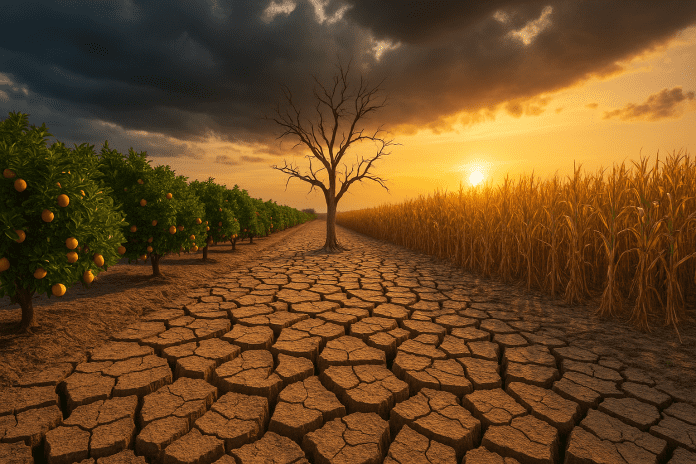🕒 Last updated on August 4, 2025
Changing Weather Patterns and Food Inflation in Florida
Florida is one of the biggest producers of fruits and vegetables in the United States. The state also supports large dairy and beef-cattle farming industries. Its warm climate has always made it perfect for growing a wide variety of crops. But in recent years, Florida’s weather has started to change in ways that are creating serious problems for farmers, adding to the pressures of rising food inflation across the country.
Compared to past decades, winters in Florida are now milder. There are fewer freezing nights, and summers begin earlier and are much hotter. The nights are also warmer, giving plants and animals less time to cool down and recover. Rainfall has become less regular. When it does rain, it pours heavily, often causing waterlogging or even flooding.
These changes are making it harder for crops to grow properly. Hotter nighttime temperatures affect the health of plants and livestock. Crops grow smaller, and animals become more stressed and less productive. These conditions also increase the risk of disease. At the same time, crops’ nutritious value is declining due to increased air carbon dioxide levels.
Another significant problem is hurricanes. Hurricanes are getting stronger and occurring more frequently as oceans warm. These storms cause hundreds of millions of dollars in damage to Florida’s agriculture every year. Salt water from rising sea levels also seeps into the soil, making it harder to grow crops in coastal areas.
Severe Weather Disrupts Travel Plans in Chicago
Florida’s famous citrus industry is facing even more problems. Apart from storm damage, the trees are suffering from citrus greening, a disease spread by insects. The 2024–25 season was the least productive in over a hundred years. These losses directly contribute to food inflation as fewer citrus fruits are available in the market.
Climate Events and Supply Chains Behind Food Inflation
One important weather pattern that affects Florida is El Niño. This natural event involves changes in wind and sea temperatures in the Pacific Ocean. During an El Niño phase, ocean waters get warmer, and trade winds weaken. This can cause changes in weather around the world, including more rainfall in some parts of Florida and drought in others.
Although it’s hard to connect a single weather event to the price of one food item, scientists agree that extreme weather caused by climate change has an overall impact on food supply. The systems that bring food from farms to grocery stores are very complicated. A storm or drought in one place can create a ripple effect across the entire country.
Severe Weather Disrupts Travel Plans in Chicago
For example, if heavy rains ruin a large number of tomato crops in Florida, the supply of tomatoes in the market drops. With fewer tomatoes available, prices rise. When this happens across different crops and states, it builds up to a major rise in food inflation. This affects households across the country, especially low-income families already struggling with their grocery bills.
Other factors like higher labor costs and leftover supply chain problems from the pandemic are also pushing up food prices. But experts now believe that climate change is playing a growing role. Every time a natural disaster hits farmland or affects the growing season, food production becomes more expensive and food inflation increases.
Insurance Costs and Farming Challenges
Farmers in Florida face financial challenges beyond just damaged crops. They require insurance to safeguard their property, just like homeowners do. They also often buy crop insurance to cover losses when crops fail. These insurance policies have become more expensive in recent years due to the rising number of weather-related disasters.
Row crops like corn and soybeans, mostly grown in North Florida, are more commonly insured than specialty crops like strawberries and oranges found in the south. But the rise in natural disasters has caused a jump in insurance costs for all types of farms. As insurance premiums go up, farmers are forced to spend more money just to protect their work.
This directly contributes to food inflation. Farmers pass along some of their increased costs to grocery stores and suppliers, who then pass them on to consumers. In some cases, farmers may decide to sell their land or retire, especially when they can no longer afford to manage the risks. With the average age of farmers approaching 60, fewer young people are choosing to enter the business. Farming is becoming more difficult and less profitable.
✈️ Climate fury at 30,000 feet—turbulence injures passengers on rising number of flights
To stay in business, many farmers are now turning to technology. They use predictive modeling and data to plan how to grow crops more effectively. However, these tools depend on accurate weather and climate data. Recent budget cuts to national weather services are putting this information at risk, which could indirectly worsen food inflation by reducing the accuracy of planning.
Without access to detailed forecasts and climate trends, it becomes harder for farmers to make smart decisions. The lack of reliable data could lead to more crop failures, more losses, and ultimately, even higher food inflation in the coming years.

